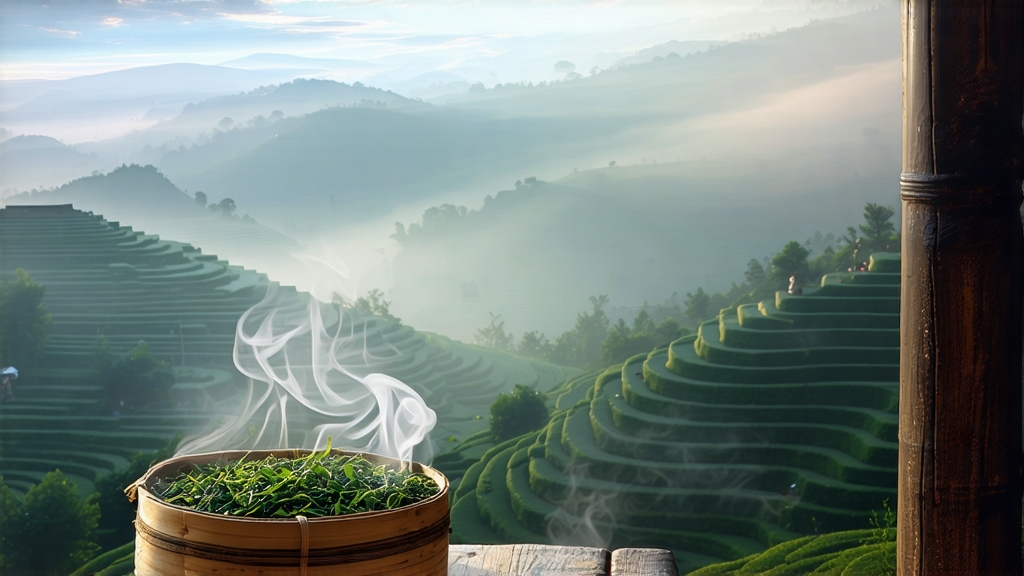
Ask most tea lovers to name China’s black teas and they will reel off Keemun, Yunnan Gold or Dian Hong, yet few realize that every one of those styles descends from a single, audacious invention born four centuries ago in the granite gorges of northern Fujian. Lapsang Souchong—literally “smoky variety from the original mountain village”—is not just another black tea; it is the primordial black tea, the first leaf ever fully oxidized, the prototype that launched a global obsession. To understand it is to hold the keystone of world tea history in your cup.
Origin and legend
The Wuyi Mountains, a UNESCO dual heritage site, rise in knife-edge ridges shrouded year-round in cloud. Villagers in Tongmu, a protected enclave reachable only by footbridge and stone path, tell the story of a Qing-era army bivouacking in tea sheds during the busy spring harvest. The soldiers slept on piles of fresh leaves, bruising them beyond the point suitable for the customary green-tea pan-firing. Facing financial ruin, the farmer placed the darkened leaves over smoldering pine to dry, hoping the fragrant smoke would mask the spoilage. To everyone’s astonishment, the Dutch traders who received the shipment at Xiamen port loved the novel flavor, paid double, and returned the next year asking for “the smoked tea.” Thus, in the smoky chaos of 1646, black tea was born.
Micro-terroir
Tongmu sits at 27° N latitude between 600 m and 1,200 m elevation. The granite soil is so poor that tea bushes must struggle, concentrating aromatic compounds. Humidity hovers at 85 %, nurturing a slow leaf growth that yields unusually high levels of linalool and geraniol—volatiles that later marry with pine smoke to create the tea’s signature note of longan and resin. Only six indigenous cultivars are permitted inside the core zone: Xiao Ye Zhong (small leaf), Ai Jiao (dwarf heel), and four clonal selections collectively called “Wuyi Qizhong.” Leaves picked outside this 565-hectare polygon may be called “Zheng Shan” (original mountain) but never “Tongmu,” a legally protected geographical indication since 2002.
Two faces of Souchong
International markets know Lapsang largely as a heavily smoked export commodity, yet connoisseurs cherish an unsmoked, gorgeously malty version called “unsmoked Lapsang” or “original aroma” (原味). The divergence occurs at the final drying stage, giving rise to two stylistic lineages:
- Traditional Smoke-dried (熏种) – leaves absorb volatiles from burning Masson pine and Chinese red pine in a two-story wooden loft called a qinglou.
- Modern Unsmoked (无烟种) – leaves are dried with hot air circulated through electric ovens, showcasing the cultivar’s innate honey, lychee and mineral notes.
Both styles share identical plucking standards: one bud plus two or three leaves, harvested before Qingming when the spring mist is thickest. After picking, the leaves must travel down the mountain within three hours; any delay oxidizes the edges prematurely, flattening the later layers of flavor.
Crafting the leaf
Withering begins on bamboo screens set over riverside rocks whose residual warmth provides gentle bottom heat. Masters judge readiness by the “soft ear” test: a leaf bent between thumb and forefinger must emit a faint crack yet not snap. This takes 6–8 hours depending on cloud cover. Rolling follows in cast-iron basins lined with hemp cloth; pressure is applied in three short bursts to bruise cells without macerating the leaf, critical for even oxidation. The oxidization itself occurs in wooden troughs nestled inside the qinglou ground floor. Here temperature is kept at 24 °C with 80 % humidity; tea masters listen for the tell-tale rustle when leaves are tossed—like wind through bamboo—indicating that moisture is evacuating uniformly. When the leaf turns a coppery maroon with faint green veins, oxidation is arrested by moving the leaf to the upper floor where pine logs smolder below wire mesh. In 20 minutes the leaf moisture drops from 60 % to 18 %, locking in smoky phenols. A final charcoal bake at 70